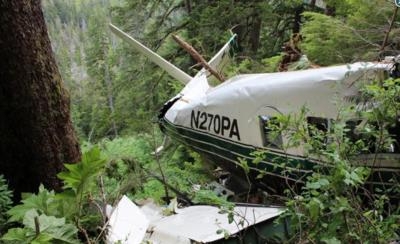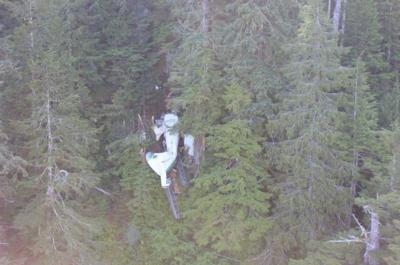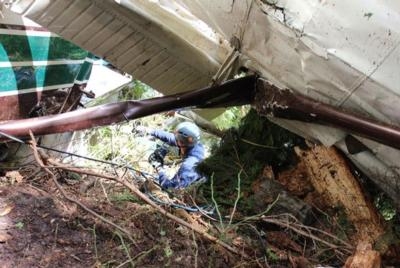Nine On Board The Aircraft Fatally Injured
The NTSB has released its preliminary report from an accident involving at sightseeing aircraft that impacted terrain near Ketchikan, AK, resulting in the fatal injury of the nine people on board. Eight of those were cruise ship passengers on a shore excursion.

According to the report, on June 25, 2015, about 1215 Alaska daylight time, a single-engine, turbine-powered, float-equipped de Havilland DHC-3 (Otter) airplane, N270PA, sustained substantial damage when it impacted mountainous tree-covered terrain, about 24 miles northeast of Ketchikan, Alaska. The airplane was being operated under the provisions of 14 Code of Federal Regulations (CFR) Part 135, as an on-demand visual flight rules (VFR) sightseeing flight when the accident occurred. The airplane was owned by Pantechnicon Aviation, of Minden, Nevada, and operated by Promech Air, Inc., of Ketchikan. The commercial pilot and eight passengers were fatally injured. Marginal visual meteorological conditions were reported in the area at the time of the accident. The flight departed a floating dock located in Rudyerd Bay about 44 miles northeast of Ketchikan about 1200 for a tour through Misty Fjords National Monument Wilderness. A company VFR flight plan was in effect. At the time of the accident, the
flight was returning to the operator's base at the Ketchikan Harbor Seaplane Base, Ketchikan.
The flight was a sightseeing flight for passengers of a cruise ship that was docked in Ketchikan. The tour, named Cruise/Fly, consisted of two groups of passengers. One group departed Ketchikan onboard a marine vessel and the other group departed via airplane, with a predetermined rendezvous at the floating dock in Rudyerd Bay. Once at the floating dock, the two groups would switch transportation modes for the return trip to Ketchikan.
The operator reported that the accident airplane departed Rudyerd Bay as the third of four float-equipped airplanes on air tour flights over the Misty Fjords National Monument Wilderness. The airplanes departed about 5 minutes apart, and the standard route of flight was southwest, over an area of remote inland fjords, coastal waterways, and mountainous tree-covered terrain.

When the airplane failed to return to Ketchikan, the operator initiated a search for the missing airplane and heard an emergency locator transmitter (ELT) signal along the accident pilot's anticipated route of flight. A helicopter from Temsco Helicopters, Inc., of Ketchikan, was dispatched to the suspected accident site to search for the missing airplane. However, the helicopter pilot said that he was unable to search the upper levels of the mountainous areas due to low ceilings and poor visibility. The helicopter pilot said that, after waiting for the weather conditions to improve, he was able to search the upper elevations of the search area and located the wreckage about 1429. The Ketchikan Volunteer Rescue Squad (KVRS) team members reached the accident site and confirmed that the airplane's occupants had sustained fatal injuries.
The NTSB investigator-in-charge along with another NTSB investigator, with help from KVRS, reached the accident site on the morning of June 27. The airplane impacted trees and a near vertical rock face in a nose high, wings level attitude at an elevation of about 1,600 feet mean sea level and came to rest upright on top of its separated floats, in an area of heavily forested, steep terrain.
The accident airplane was equipped with an avionics package known as automatic dependent surveillance-broadcast (ADS-B), which is also known as "Capstone." ADS-B technology provides pilots with situational awareness by displaying the airplane's position over terrain, while using GPS technology, coupled with an instrument panel mounted, moving map display. The ADS-B equipment installed in the accident airplane included two Chelton multifunction display (MFD) units. One MFD provides the pilot with a moving map with terrain awareness information, and the other provides primary flight display information. The two MFD units were removed from the wreckage and shipped, to the NTSB vehicle recorder laboratory, Washington, D.C.
The accident airplane was equipped with a Pratt & Whitney PT6A-135A engine that produces 750 shaft horsepower.

A comprehensive NTSB postaccident examination of the engine and airframe is pending, after the airplane wreckage is recovered to Ketchikan.
The closest weather reporting facility is Ketchikan Airport (KTN), Ketchikan, AK, about 24 miles southwest of the accident site. At 1153, an aviation routine weather report (METAR) at KTN reported in part: wind 130 degrees at 15 knots, gust 23 knots; visibility 6 statute miles, rain and mist, runway 11 visual range 4,000 variable to greater than 6,000 feet; few clouds 800 feet, broken clouds 1,200 feet, overcast clouds 2,700 feet; 61 degrees F; dew point 57 degrees F; altimeter 29.91 in Hg.
(NTSB Images)
 ANN's Daily Aero-Term (04.24.24): Runway Lead-in Light System
ANN's Daily Aero-Term (04.24.24): Runway Lead-in Light System ANN's Daily Aero-Linx (04.24.24)
ANN's Daily Aero-Linx (04.24.24) Aero-FAQ: Dave Juwel's Aviation Marketing Stories -- ITBOA BNITBOB
Aero-FAQ: Dave Juwel's Aviation Marketing Stories -- ITBOA BNITBOB Classic Aero-TV: Best Seat in The House -- 'Inside' The AeroShell Aerobatic Team
Classic Aero-TV: Best Seat in The House -- 'Inside' The AeroShell Aerobatic Team Airborne Affordable Flyers 04.18.24: CarbonCub UL, Fisher, Affordable Flyer Expo
Airborne Affordable Flyers 04.18.24: CarbonCub UL, Fisher, Affordable Flyer Expo





